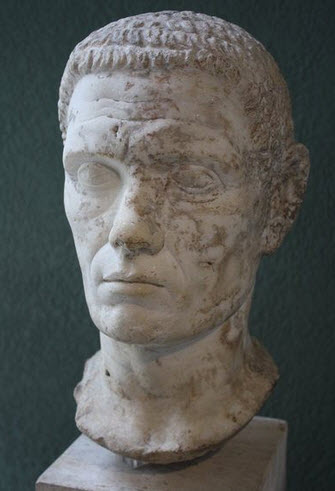Under the reign of Emperor Claudius (i.e. in 41-54 AD), the Roman Empire went through its first major expansion since the reign of Augustus (i.e. since 27 BC – 14 AD). During the reigns of Tiberius and Caligula, respectively, there had been no major expansions of the empire’s territory.

With Claudius at the helm, the empired annex several new provinces and put others under direct rule. Example of provinces that were incorporated into the empire in one way or the other are Lycia, Thrace, Judea, Noricum, Pamphylia, and Mauretania. Emperor Caligula had attemped to annex Mauretania, but this project wasn’t completed until the reign of Claudius, when local resistance forces were defeated and Mauretania – which had been a client kingdom – was turned into two imperial provinces.
When a census was carried out in 48 AD, it showed that there were 5,984,072 Roman citizens. (At that time, only an adult free male could be a Roman citizen.) This was roughly one million citizens more than for the census carried out at the death of Emperor Augustus, and an important reason for this increase was Emperor Claudius’ expansion of the Roman Empire and his fondness of granting blanket citizenship to free adult males living in newly established Roman colonies.
Britannia
One of the most famous imperial conquests during the reign of Claudius was that of the far away land known to the Romans as Britannia. This place had two main attractions for the empire: mines and slave labour.
 In 43 AD, Emperor Claudius sent four legions to Britannia, as a respons to a request put forward by an outsted tribal ally. The legions were led by Aulus Plautius.
In 43 AD, Emperor Claudius sent four legions to Britannia, as a respons to a request put forward by an outsted tribal ally. The legions were led by Aulus Plautius.
Once the initial offensives had been carried out, Emperor Claudius himself travelled to Britannia, accompanied by soldiers and war elephants, and remained there for slightly more than two weeks. Back in Rome, the Senate granted him a triumph (a type of rare and special celebritory ceremony). He was also granted the honorific Britannicus, which he accepted on behalf of his son Tiberius who became known as Britannicus.
In the new Roman province Britannia, the town Camulodunum was established as the provincial capital and a large temple was built there in honor of Emperor Claudius. After his death in 54 AD, Camuldonum was formally renamed Colonia Claudia Victricensis after him. Today, we know this English city as Colchester.
Arch of Claudius
The Arch of Claudius was built in honor of Emperor Claudius’ successful invasion of Britannia. The arch itself has not survived into our time, but its inscription can be seen at the Capitoline Museums in Rome. Among other things, it praises Claudius for having “received the surrender of eleven kings of the Britons” and for being the first to bring “barbarian peoples across the Ocean into the dominion of the Roman people”.
There are ancient Roman coins that show the arch on their reverse side, and they were issued in 46-47 AD and 49 AD even though the arch wasn’t dedicated until 51 AD. The coins show the arch surmounted by an equestrian statue between two trophies.
The arch seems to have been in ruins as early as the 900s AD. In 1562, portions of the structure was discovered, and similar discoveries were also made in 1641 and 1869.
